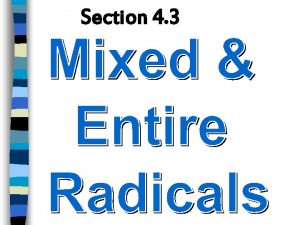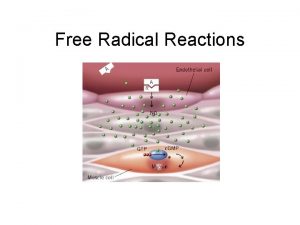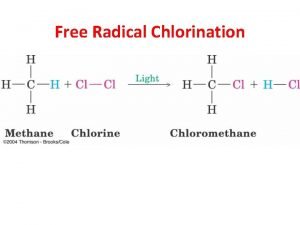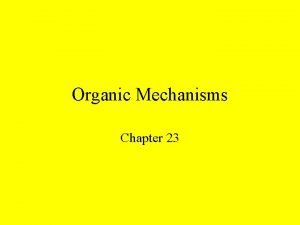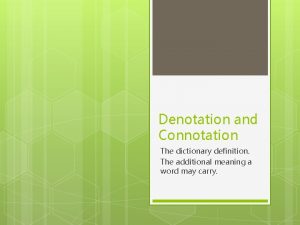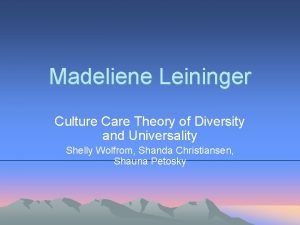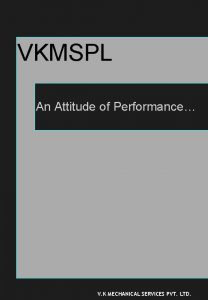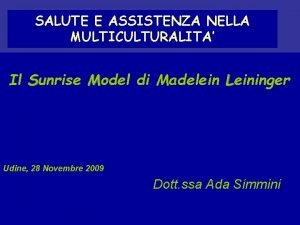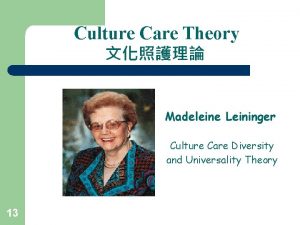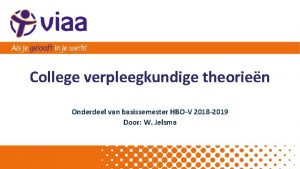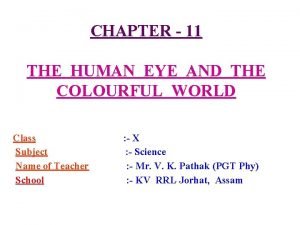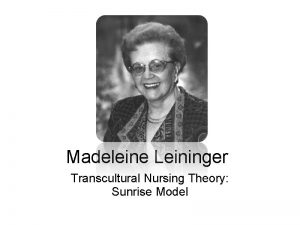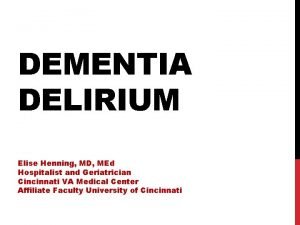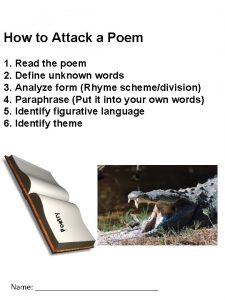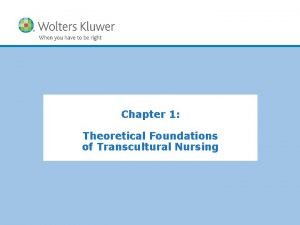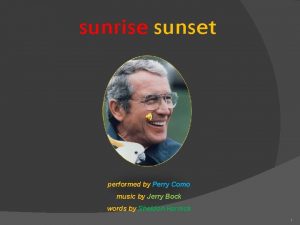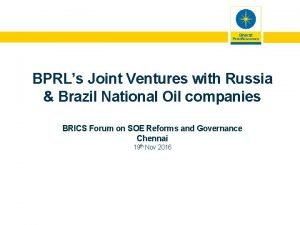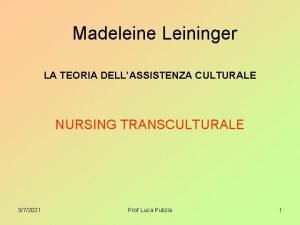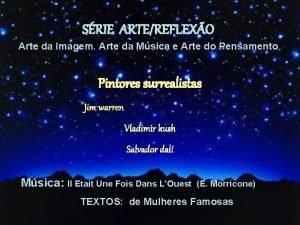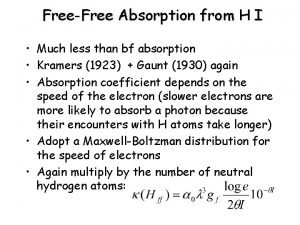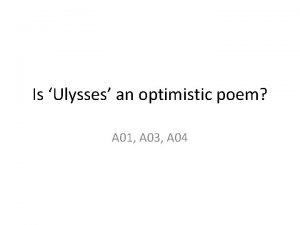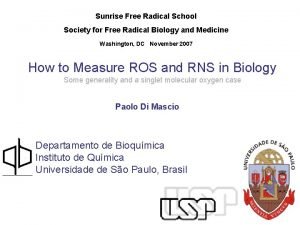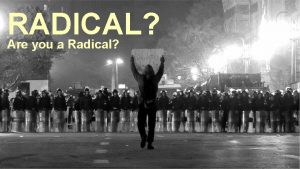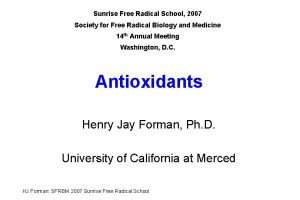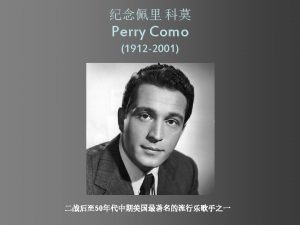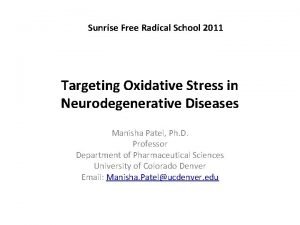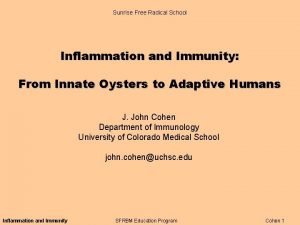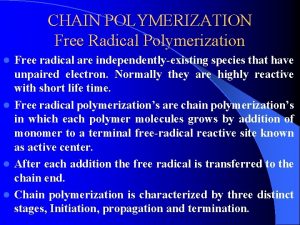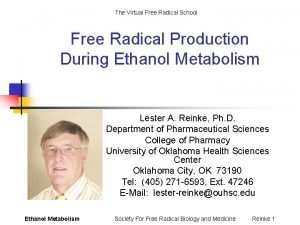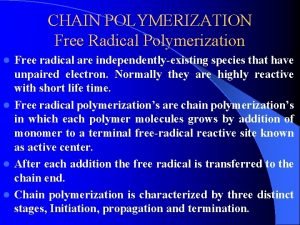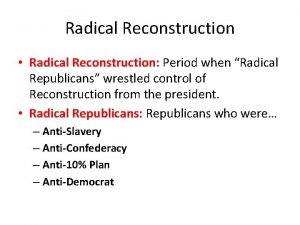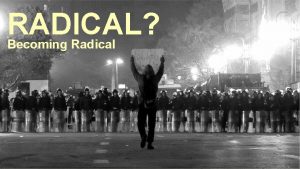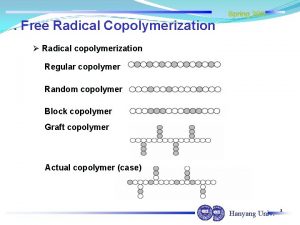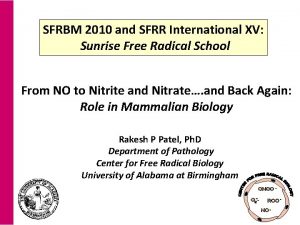What is a Free Radical Sunrise Free Radical











![Lipid Peroxidation Ox LO not a good propagator Ref [5, 6] Buettner GR SFRBM Lipid Peroxidation Ox LO not a good propagator Ref [5, 6] Buettner GR SFRBM](https://slidetodoc.com/presentation_image/34ae187ed32e33170c5095721668c235/image-12.jpg)






![The Pecking Order [7] Redox Couple (one-electron reductions) HO , H+/H 2 O RO The Pecking Order [7] Redox Couple (one-electron reductions) HO , H+/H 2 O RO](https://slidetodoc.com/presentation_image/34ae187ed32e33170c5095721668c235/image-19.jpg)




![Iron from Syringes Treatment, p. H 7. 4 PO 4 [Fe]/ M 1 Untreated Iron from Syringes Treatment, p. H 7. 4 PO 4 [Fe]/ M 1 Untreated](https://slidetodoc.com/presentation_image/34ae187ed32e33170c5095721668c235/image-24.jpg)




![Nitric Oxide, an antioxidant [9, 10, 11] Buettner GR SFRBM 2007 Sunrise Free Radical Nitric Oxide, an antioxidant [9, 10, 11] Buettner GR SFRBM 2007 Sunrise Free Radical](https://slidetodoc.com/presentation_image/34ae187ed32e33170c5095721668c235/image-29.jpg)



![Compare rates, not k Rate = k [Target] x [H 3 COO ] = Compare rates, not k Rate = k [Target] x [H 3 COO ] =](https://slidetodoc.com/presentation_image/34ae187ed32e33170c5095721668c235/image-33.jpg)
![Easiest to compare k’ Rate = k [Target] x [H 3 COO ] = Easiest to compare k’ Rate = k [Target] x [H 3 COO ] =](https://slidetodoc.com/presentation_image/34ae187ed32e33170c5095721668c235/image-34.jpg)



- Slides: 37

What is a Free Radical? Sunrise Free Radical School 14 th Annual meeting of SFRBM November 14 -18, 2007 Garry R. Buettner, Ph. D. Free Radical & Radiation Biology and ESR Facility The University of Iowa City, IA 52242 -1101 Buettner GR SFRBM 2007 Sunrise Free Radical School 1

or, What is a Radical? A free radical is an atom or group of atoms possessing one or more unpaired electrons [1, 2]. The word "free" in front of "radical" is, in this era, considered unnecessary [1, 2]. Buettner GR SFRBM 2007 Sunrise Free Radical School 2

Historically: What is a Free Radical? Historically, radical and free radical had different, but related meanings. For example, Linus Pauling defined them as [3]: "Free Radicals. An atom or group of atoms with one or more unshared electrons, which may enter into chemical-bond formation, is called a free radical. (The same group in a molecule is called a radical; for example, the methyl radical in methyl cyanide or other molecules. )” Thus, when reading older literature be aware of this nuance in meaning. We now realize that not all free radicals will react to make covalent bonds. Buettner GR SFRBM 2007 Sunrise Free Radical School 3

Free Radical Notation? A. Superscript dot to the right, usually B. Examples (Note: dot, then charge) H , Cl , HO , or (HO) O 2 or O 22 dioxygen, the O 2 you are breathing now. H 3 C O 2 - , CO 2 -, Asc -, PQ + Buettner GR SFRBM 2007 Sunrise Free Radical School 4

Common Notations and Abbreviations Species Systematic IUPAC Name Alternative/Comments O O 2 O 3 HO HO 2 oxide(1 -) hydroxyl radical without proton dioxide(1 -) superoxide trioxygen ozone trioxide(1 -) ozonide hydroxyl not hydroxy, hydroxide is OH hydrogen dioxide hydrodioxyl, or hydroperoxyl, but perhydroxyl does not make sense HO 2 H 2 O 2 RO ROOH ONOOH NO hydrogen dioxide(1 -) hydrogenperoxide(1 -) Buettner GR hydrogen peroxide alkoxyl not alkoxy alkyldioxyl alkylperoxyl not peroxy alkyl hydroperoxide oxoperoxonitrate (1 -) peroxynitrite hydrogen oxoperoxonitrate peroxynitrous acid nitrogen monoxide nitric oxide SFRBM 2007 Sunrise Free Radical School 5

Types of radicals; we have: Sigma, pi-delocalized, Mixture of sigma and pi Carbon-centered, H 3 C O 2–centered, H 3 COO Sulfur-centered, GS Nitrogen-centered, R 2 NO Reducing radicals, CO 2 -, PQ + Oxidizing radicals, HO , LOO , CO 3 Buettner GR SFRBM 2007 Sunrise Free Radical School 6

Reactivity, wide range k = very, very slow at RT O 22 + CH 4 [Intermediates] … k = 5 x 109 M-1 s-1 O 22 + H 3 COO Radical + Radical rxns typically very fast Radical + non-radical wide range Buettner GR SFRBM 2007 Sunrise Free Radical School 7

Why is ground state O 2 (O 22 : 3 -g) so reactive—yet unreactive? The Spin Restriction [4] 1. 2. 3. 4. 5. Can orbitals overlap to form a reasonable transition state? Activation energy of oxygen! Ea 23 kcal/mole for 3 O 2 reactions, i. e. 1 O 2 3 O + 1(carbon) Products, 2 but very slow! Progress of Rxn Buettner GR SFRBM 2007 Sunrise Free Radical School 8

Why does ground state O 2 react so fast with many radicals? There is no spin restriction [4]. 1. Radical-radical reactions will not have to overcome the spin restriction. 2. Ea typically very small Progress of Rxn Buettner GR SFRBM 2007 Sunrise Free Radical School 9

Example Rxns 1 ROO + (PUFA)* pentadienyl radical + ROOH Slow, k 50 M-1 s-1 (for bis-allylic hydrogens) *It is only the PUFA in lipids that are oxidizable. Oxidizability number of double bonds [13] Buettner GR SFRBM 2007 Sunrise Free Radical School 10

Example Rxns 2 H 3 C + O 2 NO + O 2 Buettner GR H 3 COO O=NOO- k = 2 x 109 M-1 s-1 k = 1 x 1010 M-1 s-1 SFRBM 2007 Sunrise Free Radical School 11
![Lipid Peroxidation Ox LO not a good propagator Ref 5 6 Buettner GR SFRBM Lipid Peroxidation Ox LO not a good propagator Ref [5, 6] Buettner GR SFRBM](https://slidetodoc.com/presentation_image/34ae187ed32e33170c5095721668c235/image-12.jpg)
Lipid Peroxidation Ox LO not a good propagator Ref [5, 6] Buettner GR SFRBM 2007 Sunrise Free Radical School 12

Kinetics rule The competition 3 x 108 M-1 s-1 L + O 2 LOO Propagation 10 - 50 M-1 s-1 L + LOOH LOO + L-H Vitamin E 105 M-1 s-1 in membranes or LDL LOO + TOH Buettner GR Cycle TO + L-H SFRBM 2007 Sunrise Free Radical School 13

Tocopherol in Action Buettner GR SFRBM 2007 Sunrise Free Radical School 14

Ascorbate a Donor Antioxidant X -0. 8 Buettner GR SFRBM 2007 Sunrise Free Radical School 15

C and E as Co-Antioxidants Buettner GR SFRBM 2007 Sunrise Free Radical School 16

C and E as Co-Antioxidants Buettner GR SFRBM 2007 Sunrise Free Radical School 17

Thermodynamics Both, kinetics and thermodynamics are involved in the control of antioxidant reactions. Buettner GR SFRBM 2007 Sunrise Free Radical School 18
![The Pecking Order 7 Redox Couple oneelectron reductions HO HH 2 O RO The Pecking Order [7] Redox Couple (one-electron reductions) HO , H+/H 2 O RO](https://slidetodoc.com/presentation_image/34ae187ed32e33170c5095721668c235/image-19.jpg)
The Pecking Order [7] Redox Couple (one-electron reductions) HO , H+/H 2 O RO , H+/ROH (aliphatic alkoxyl radical) ROO , H+/ROOH (alkyl peroxyl radical) GS /GS (glutathione) PUFA , H+/PUFA-H (bis-allylic-H) TO , H+/TOH H 2 O 2, H+/H 2 O, HO Asc , H+/Asc. HCo. QH , H+/Co. QH 2 Fe(III) EDTA/ Fe(II) EDTA O 2/ O 2 Co. Q/Co. Q Paraquat 2+/ Paraquat + Fe(III)DFO/ Fe(II)DFO RSSR/ RSSR (GSH) H 2 O/ e aq Buettner GR SFRBM 2007 Sunrise Free Radical School E°'/m. V + 2310 + 1600 + 1000 + 920 + 600 + 480 + 320 + 282 + 190 + 120 - 160 - 230 - 448 - 450 - 1500 - 2870 19

Jumping to the top, Fenton Rxn Redox Couple (one-electron reductions) E°'/m. V HO , H+/H 2 O + 2310 RO , H+/ROH (aliphatic alkoxyl radical) + 1600 ROO , H+/ROOH (alkyl peroxyl radical) + 1000 GS /GS (glutathione) + 920 PUFA , H+/PUFA-H (bis-allylic-H) + 600 TO , H+/TOH + 480 H 2 O 2, H+/H 2 O, HO + 320 Asc , H+/Asc. H- + 282 Co. QH , H+/Co. QH 2 + 190 Fe(III) EDTA / Fe(II) EDTA + 120 Buettner GR SFRBM 2007 Sunrise Free Radical School 20

Jumping up in lipid peroxidation Redox Couple (one-electron reductions) E°'/m. V HO , H+/H 2 O + 2310 RO , H+/ROH (aliphatic alkoxyl radical) + 1600 ROO , H+/ROOH (alkyl peroxyl radical) + 1000 GS /GS (glutathione) + 920 PUFA , H+/PUFA-H (bis-allylic-H) + 600 TO , H+/TOH + 480 H 2 O 2, H+/H 2 O, HO + 320 Asc , H+/Asc. H- + 282 Co. QH , H+/Co. QH 2 + 190 Fe(III) EDTA/ Fe(II) EDTA + 120 Buettner GR SFRBM 2007 Sunrise Free Radical School 21

Trouble, trouble … When a reaction produces a product that “jumps up” in the Pecking Order. HO , H+/H 2 O + 2310 ROO , H+/ROOH (alkyl peroxyl radical) + 1000 PUFA , H+/PUFA-H (bis-allylic-H) + 600 H 2 O 2, H+/H 2 O, HO + 320 Note: the reaction of L (PUFA ) with O 2 will result in a species higher in the Pecking Order (ROO above); likewise with the Fenton Rxn, HO. Buettner GR SFRBM 2007 Sunrise Free Radical School 22

Iron, a bit of history 1. Iron contaminates buffers, 0. 1 – 1 or more M; 2. Choice of chelating agent can change observations; 3. DETAPAC (DTPA) introduced to free radical community; 4. Iron a big player in spin trapping; 5. Everything goes better with DETAPAC (DTPA). Buettner, G. R. and Oberley, L. W. (1978) "Considerations in the spin trapping of superoxide and hydroxyl radicals in aqueous systems using 5, 5 -dimethyl-1 -pyrroline-1 -oxide. " Biochem. Biophys. Res. Commun. 83: 69 -74. ( and the Pinawa Meeting, 1977) Buettner, G. R. , Oberley, L. W. , and Leuthauser, S. W. H. C. (1978) "The effect of iron on the distribution of superoxide and hydroxyl radicals as seen by spin trapping and on the superoxide dismutase assay. " Photochem. Photobiol. 28: 693 -695. ( and the Pinawa Meeting, 1977) Buettner GR SFRBM 2007 Sunrise Free Radical School 23
![Iron from Syringes Treatment p H 7 4 PO 4 Fe M 1 Untreated Iron from Syringes Treatment, p. H 7. 4 PO 4 [Fe]/ M 1 Untreated](https://slidetodoc.com/presentation_image/34ae187ed32e33170c5095721668c235/image-24.jpg)
Iron from Syringes Treatment, p. H 7. 4 PO 4 [Fe]/ M 1 Untreated Chelex 100 (See [12]) 0. 01 probably < 1 n. M 5. 0 2. 9 Hamilton, 705 -N Gas-Tight, Hamilton 1705 -TEF (22 S Steel needle) 1705 -TEF (Teflon needle) 1725 -TEF LL (Steel needle) 1725 -TEF LL (Teflon needle) 0. 18 0. 12 0. 14 0. 03 0. 061 0. 008 0. 015 0. 007 Buettner, G. R. (1990) Ascorbate oxidation: UV absorbance of ascorbate and ESR spectroscopy of the ascorbyl radical as assays for iron. Free Rad Res Commns, 10: 5 -9. Buettner GR SFRBM 2007 Sunrise Free Radical School 24

Iron, mechanisms Fe(III)chelate + O 2 Fe(II)chelate + O 2 or Fe(III)chelate + Asc. H Fe(II)chelate + Asc Then, Fe(II)chelate + H 2 O 2 or HO + Fe(III)chelate LOOH LO or Fe(II) + O 2 Buettner GR Oxidants SFRBM 2007 Sunrise Free Radical School [8] 25

Chelates, can drive Fe(II) oxidation E (Fe(III)Desferal/Fe(II)Desferal) = - 450 m. V Kstability Fe(III) ~ 1030. 6 Kstability Fe(II) ~ 107. 2 Buettner GR SFRBM 2007 Sunrise Free Radical School 26

Chelates, can be great for Fenton rxn E (Fe(III)EDTA/Fe(II)EDTA) = +120 m. V k (Fe(II)EDTA + H 2 O 2) ~ 104 M-1 s-1 EDTA DTPA, DETAPAC Buettner GR SFRBM 2007 Sunrise Free Radical School 27

EDTA, Coordination of Fe(III) Buettner GR SFRBM 2007 Sunrise Free Radical School 28
![Nitric Oxide an antioxidant 9 10 11 Buettner GR SFRBM 2007 Sunrise Free Radical Nitric Oxide, an antioxidant [9, 10, 11] Buettner GR SFRBM 2007 Sunrise Free Radical](https://slidetodoc.com/presentation_image/34ae187ed32e33170c5095721668c235/image-29.jpg)
Nitric Oxide, an antioxidant [9, 10, 11] Buettner GR SFRBM 2007 Sunrise Free Radical School 29

Vit E vs NO : Kinetics k. NO 2 x 109 M-1 s-1 NO + LOONO k. TOH 105 M-1 s-1 TOH + LOO TO + LOOH k. NO 5 x 109 M-1 s-1 k. TOH 105 M-1 s-1 k. NO / k. TOH 104 – 105 Buettner GR SFRBM 2007 Sunrise Free Radical School 30

Kinetics, rate constants Many free radical reactions are controlled by second order rate laws: Rate = k [Target]1 x [Radical]1 Consider possible reaction of peroxyl radicals, e. g. H 3 COO Buettner GR SFRBM 2007 Sunrise Free Radical School 31

Peroxyl radical rxns H 3 COO + D-H H 3 COOH + D k (PUFA) k (GSH) k (TOH) k (Asc. H-) k (NO ) 1 x 102 2 x 104 1 x 105 2 x 106 2 x 109 = = = M-1 s-1 M-1 s-1 * * H 3 COO + NO H 3 COONO Buettner GR SFRBM 2007 Sunrise Free Radical School 32
![Compare rates not k Rate k Target x H 3 COO Compare rates, not k Rate = k [Target] x [H 3 COO ] =](https://slidetodoc.com/presentation_image/34ae187ed32e33170c5095721668c235/image-33.jpg)
Compare rates, not k Rate = k [Target] x [H 3 COO ] = k’ [H 3 COO ] k (PUFA) = 1 x 102 M-1 s-1 [1 x 10 -3 M] k (GSH) = 2 x 104 M-1 s-1 [3 x 10 -3 M] k (TOH) = 1 x 105 M-1 s-1 [1 x 10 -3 M] k (Asc. H-) = 2 x 106 M-1 s-1 [3 x 10 -3 M] k (NO ) = 2 x 109 M-1 s-1 [5 x 10 -8 M] Buettner GR SFRBM 2007 Sunrise Free Radical School 33
![Easiest to compare k Rate k Target x H 3 COO Easiest to compare k’ Rate = k [Target] x [H 3 COO ] =](https://slidetodoc.com/presentation_image/34ae187ed32e33170c5095721668c235/image-34.jpg)
Easiest to compare k’ Rate = k [Target] x [H 3 COO ] = k’ [H 3 COO ] k k’ k (PUFA) = 1 x 102 M-1 s-1 [1 x 10 -3 M] = 1 x 10 -1 s-1 k (GSH) = 2 x 104 M-1 s-1 [3 x 10 -3 M] = 2 x 101 s-1 k (TOH) = 1 x 105 M-1 s-1 [1 x 10 -3 M] = 1 x 102 s-1 k (Asc. H-) = 2 x 106 M-1 s-1 [3 x 10 -3 M] = 2 x 103 s-1 k (NO ) = 2 x 109 M-1 s-1 [5 x 10 -8 M] = 2 x 101 s-1 Buettner GR SFRBM 2007 Sunrise Free Radical School 34

Fun, but serious science Free Radicals and related oxidants. Understanding their reactions assists in understanding their biology. Future: The need is to progress to more quantitative approaches in the biology of free radicals, related oxidants, and antioxidants, i. e. quantitative redox biology. Buettner GR SFRBM 2007 Sunrise Free Radical School 35

References-1 1. Koppenol WH. (2000) Names for inorganic radicals. Pure Appl Chem. 72: 437 -446. http: //www. iupac. org/publications/pac/2000/7203 pdf/7203 koppenol_437. pdf 2. Koppenol WH. (1990) What is in a name? Rules for radicals. Free Radic Biol. Med 9: 225227. http: //dx. doi. org/10. 1016/0891 -5849(90)90032 -E 3. Pauling L. (1964) College Chemistry. W. H. Freeman & Co. pp 331 -332. 4. Miller DM, Buettner GR, Aust SD. (1990) Transition metals as catalysts of “autoxidation” reactions. Free Radic Biol Med. 8: 95 -108. http: //dx. doi. org/10. 1016/08915849(90)90148 -C 5. Qian SY, Wang HP, Schafer FQ, Buettner GR. (2000) EPR detection of lipid-derived radicals from PUFA, LDL, and cell oxidations. Free Radic Biol Med. 29: 568 -579. http: //dx. doi. org/doi: 10. 1016/S 0891 -5849(00)00407 -X 6. Schafer FQ, Wang HP, Kelley EE, Cueno KL, Martin SM, Buettner GR. (2002) Comparing -carotene, vitamin E and nitric oxide as membrane antioxidants. Biol. Chem 383: 671681. http: //dx. doi. org/doi: 10. 1515/BC. 2002. 069 7. Buettner GR. (1993) The pecking order of free radicals and antioxidants: Lipid peroxidation, ‑tocopherol, and ascorbate. Arch Biochem Biophys 300: 535‑ 543. http: //dx. doi. org/10. 1006/abbi. 1993. 1074 8. Qian SY, Buettner GR. (1999) Iron and dioxygen chemistry is an important route to initiation of biological free radical oxidations: An electron paramagnetic resonance spin trapping study. Free Radic Biol Med, 26: 1447 -1456. http: //dx. doi. org/doi: 10. 1016/S 0891 -5849(99)00002 -7 Buettner GR SFRBM 2007 Sunrise Free Radical School 36

References-2 9. N. Hogg, B. Kalyanaraman, J. Joseph, A. Struck and S. Parthasarathy, Inhibition of lowdensity lipoprotein oxidation by nitric oxide, potential role in atherogenesis, FEBS Lett. 334 (1993), pp. 170– 174. 10. V. B. O'Donnell, P. H. Chumley, N. Hogg, A. Bloodsworth, V. M. Darley-Usmar and B. A. Freeman, Nitric oxide inhibition of lipid peroxidation: kinetics of reaction with lipid peroxyl radicals and comparison with α-tocopherol, Biochemistry 36 (1997), pp. 15216– 15223. 11. Hummel SG, Fischer AJ, Martin SM, Schafer FQ, Buettner GR. (2006) Nitric oxide as a cellular antioxidant: A little goes a long way. Free Radic Biol Med. 40: 501 -506. http: //dx. doi. org/doi: 10. 1016/j. freeradbiomed. 2005. 08. 047 12. Buettner GR. (1988) In the absence of catalytic metals, ascorbate does not autoxidize at p. H 7: Ascorbate as a test for catalytic metals. J Biochem Biophys Meth 16: 27 -40. http: //dx. doi. org/10. 1016/0165 -022 X(88)90100 -5 13. Wagner BA, Buettner GR, Burns CP. (1994) Free radical-mediated lipid peroxidation in cells: Oxidizability is a function of cell lipid bis-allylic hydrogen content. As an Accelerated Publication in Biochemistry 33: 4449 -4453. http: //dx. doi. org/doi: 10. 1021/bi 00181 a 003 Sunrise Free Radical School, 2007 Society for Free Radical Biology and Medicine 14 th Annual Meeting Washington, D. C. Buettner GR SFRBM 2007 Sunrise Free Radical School 37
 Unit 6 test study guide radical functions answer key
Unit 6 test study guide radical functions answer key Radical section
Radical section Mixed radical examples
Mixed radical examples Free radical substitution
Free radical substitution Antioxidant free radical
Antioxidant free radical Free radical halogenation
Free radical halogenation Free radical mechanism
Free radical mechanism Negative connotation examples
Negative connotation examples Sunrise rehab darwin
Sunrise rehab darwin Sunrise enabler
Sunrise enabler Mayfair sunrise villas
Mayfair sunrise villas Campinha-bacote model
Campinha-bacote model Sunrise model
Sunrise model Sunrise deli
Sunrise deli Madeleine leininger culture care diversity and universality
Madeleine leininger culture care diversity and universality Sunrise elementary
Sunrise elementary Colors halsey lyrics
Colors halsey lyrics Nobody loves me poem
Nobody loves me poem Sunrise agriland development & research pvt. ltd.
Sunrise agriland development & research pvt. ltd. Lungscint
Lungscint Impression sunrise claude monet 1872 oil on canvas
Impression sunrise claude monet 1872 oil on canvas 11 gezondheidspatronen van gordon wikipedia
11 gezondheidspatronen van gordon wikipedia Sunrise mountain high school graduation 2021
Sunrise mountain high school graduation 2021 Advance sunrise and delayed sunset is due to
Advance sunrise and delayed sunset is due to Madeleine m. leininger metaparadigmas
Madeleine m. leininger metaparadigmas Banana sunrise chair
Banana sunrise chair Mama is a sunrise poem by evelyn tooley hunt
Mama is a sunrise poem by evelyn tooley hunt Theoretical foundation of nursing chapter 1
Theoretical foundation of nursing chapter 1 Perry como sunrise sunset
Perry como sunrise sunset Mmbpa
Mmbpa Leininger model
Leininger model Sunrise by the ocean vladimir kush
Sunrise by the ocean vladimir kush Sunrise rotary vero beach
Sunrise rotary vero beach Free free absorption
Free free absorption Gibbs free energy of formation
Gibbs free energy of formation Helmholtz free energy and gibbs free energy
Helmholtz free energy and gibbs free energy Gibbs free energy equation
Gibbs free energy equation Free hearts free foreheads
Free hearts free foreheads


